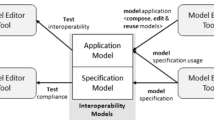Abstract
The Internet of Things (IoT) aims for connecting Anything, Anywhere, Anytime (AAA). This premise brings about heterogeneity that creates connectivity challenges. These challenges constitutes a serious obstacle to interoperability between things. Most existing approaches tackles the interoperability problem by avoiding heterogeneity with standards at runtime. While heterogeneity is an intrinsic feature of the IoT, there is a need for an approach that embraces it to connect AAA. In this paper we propose a model-based methodology to tackle the interoperability problem. It relies on a Domain-Specific Language (DSL) for a model-based specification of the network and a transformation process to generate the network artifacts from this specification. The principle consists of achieving interoperability at the model-level, then during a transformation process, ensuring that it is preserved in the low-level code. Adopting this methodology makes the engineering of the IoT more rigorous, prevents bugs earlier and saves time.
Access this chapter
Tax calculation will be finalised at checkout
Purchases are for personal use only
Similar content being viewed by others
Notes
- 1.
The concept of smart scenario refers to the ability to achieve a [smart] goal using multiple contextual factors (e.g., states of a thing, properties of a thing, space, time).
- 2.
- 3.
- 4.
CyprIoT Gihub >/language/org.atlanmod.cypriot/src/org/atlanmod/cypriot/Cypriot.xtext.
- 5.
- 6.
Subject thing: 66 LoC - Object thing: 101 LoC.
References
Aly, M., Khomh, F., Guéhéneuc, Y.-G., Washizaki, H., Yacout, S.: Is fragmentation a threat to the success of the Internet of Things? IEEE Internet Things J. 6(1), 472–487 (2018)
Atzori, L., Iera, A., Morabito, G.: The Internet of Things: a survey. Comput. Netw. 54(15), 2787–2805 (2010)
Barriga, J.K.D., Romero, C.D.G., Molano, J.I.R.: Proposal of a standard architecture of IoT for smart cities. In: International Workshop on Learning Technology for Education Challenges, pp. 77–89. Springer (2016)
Berrouyne, I., Adda, M., Mottu, J.-M., Royer, J.-C., Tisi, M.: CyprIoT: framework for modelling and controlling network-based IoT applications. In: Proceedings of the 34th ACM/SIGAPP SAC (2019)
Bröring, A., Schmid, S., Schindhelm, C.-K., Khelil, A., Käbisch, S., Kramer, D., Le Phuoc, D., Mitic, J., Anicic, D., Teniente, E.: Enabling IoT ecosystems through platform interoperability. IEEE Softw. 34(1), 54–61 (2017)
Casola, V., D’Onofrio, L., Di Lorenzo, G., Mazzocca, N.: A service-based architecture for the interoperability of heterogeneous sensor data: a case study on early warning. In: Geographic Information and Cartography for Risk and Crisis Management, pp. 249–263. Springer (2010)
Datta, S.K., Da Costa, R.P.F., Bonnet, C., Härri, J.: oneM2M architecture based IoT framework for mobile crowd sensing in smart cities. In: 2016 European Conference on Networks and Communications (EuCNC). IEEE (2016)
Ebert, C., Jones, C.: Embedded software: facts, figures, and future. Computer 42(4), 42–52 (2009)
Fortino, G., Savaglio, C., Palau, C.E., de Puga, J.S., Ganzha, M., Paprzycki, M., Montesinos, M., Liotta, A., Llop, M.: Towards multi-layer interoperability of heterogeneous IoT platforms: the inter-IoT approach. In: Integration, Interconnection, and Interoperability of IoT Systems, pp. 199–232. Springer (2018)
Gojmerac, I., Reichl, Žarko, P.P., Soursos, S.: Bridging IoT islands: the symbiote project. e & i Elektrotechnik und Informationstechnik 133(7), 315–318 (2016)
Eclipse IoT Working Group et al.: IEEE, Agile-IoT EU, and IoT Council 2018. IoT Developer Survey 2018 (2018)
Harrand, N., Fleurey, F., Morin, B., Husa, K.E.: ThingML: a language and code generation framework for heterogeneous targets. In: Proceedings of the ACM/IEEE 19th MODELS Conference (2016)
IBM Emerging Technologies: Node-RED. A visual tool for wiring the IoT (2016)
Kim, R., Poslad, S.: The thing with e. coli: highlighting opportunities and challenges of integrating bacteria in IoT and HCI. arXiv:1910.01974 (2019)
Kim, Y.G., Hong, H.S., Bae, D.-H., Cha, S.D.: Test cases generation from UML state diagrams. IEE Proc.- Softw. 146(4), 187–192 (1999)
Kreuzer, K., et al.: Openhab-empowering the smart home. Openhab. org, Technical report (2013)
Manyika, J., Chui, M., Bisson, P., Woetzel, J., Dobbs, R., Bughin, J., Aharon, D.: Unlocking the potential of the Internet of Things. McKinsey Global Institute (2015)
Niaz, I.A., Tanaka, J.: Code generation from UML statecharts. In: Proceedings of 7th IASTED International Conference on Software Engineering and Application (SEA 2003), Marina Del Rey, pp. 315–321 (2003)
Palattella, M.R., Dohler, M., Grieco, A., Rizzo, G., Torsner, J., Engel, T., Ladid, L.: Internet of Things in the 5g era: enablers, architecture, and business models. IEEE J. Sel. Areas Commun. 34(3), 510–527 (2016)
Patel, K.K., Patel, S.M., et al.: Internet of Things-IoT: definition, characteristics, architecture, enabling technologies, application & future challenges. Int. J. Eng. Sci. Comput. 6(5) (2016)
Schmid, S., Bröring, A., Kramer, D., Käbisch, S., Zappa, A., Lorenz, M., Wang, Y., Rausch, A., Gioppo, L.: An architecture for interoperable IoT ecosystems. In: International Workshop on Interoperability and Open-Source Solutions, pp. 39–55. Springer (2016)
Sendall, S., Kozaczynski, W.: Model transformation: the heart and soul of model-driven software development. IEEE Softw. 20(5), 42–45 (2003)
Wegner, P.: Interoperability. ACM Comput. Surv. 28(1), 285–287 (1996)
Xu, T., Jin, X., Huang, P., Zhou, Y., Lu, S., Jin, L., Pasupathy, S.: Early detection of configuration errors to reduce failure damage. In: 12th USENIX OSDI Proceedings (2016)
Zhang, P., Durresi, A., Barolli, L.: Policy-based mobility in heterogeneous networks. J. Ambient Intell. Humanized Comput. 4(3), 331–338 (2013)
Acknowledgements
We acknowledge the support of Institut Mines-Télécom Atlantique and the Natural Sciences and Engineering Research Council of Canada (NSERC), 06351.
Cette recherche a été financée par l’Institut Mines-Télécom Atlantique et le Conseil de recherches en sciences naturelles et en génie du Canada (CRSNG), 06351.
Author information
Authors and Affiliations
Corresponding author
Editor information
Editors and Affiliations
Rights and permissions
Copyright information
© 2020 Springer Nature Switzerland AG
About this paper
Cite this paper
Berrouyne, I., Adda, M., Mottu, JM., Royer, JC., Tisi, M. (2020). A Model-Driven Approach to Unravel the Interoperability Problem of the Internet of Things. In: Barolli, L., Amato, F., Moscato, F., Enokido, T., Takizawa, M. (eds) Advanced Information Networking and Applications. AINA 2020. Advances in Intelligent Systems and Computing, vol 1151. Springer, Cham. https://doi.org/10.1007/978-3-030-44041-1_100
Download citation
DOI: https://doi.org/10.1007/978-3-030-44041-1_100
Published:
Publisher Name: Springer, Cham
Print ISBN: 978-3-030-44040-4
Online ISBN: 978-3-030-44041-1
eBook Packages: Intelligent Technologies and RoboticsIntelligent Technologies and Robotics (R0)




